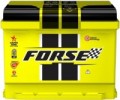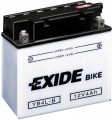Suitable for
— Motorcycle. Batteries designed for use in motorcycles. They have small dimensions, which is due, on one hand, to the relatively small amount of space available for their placement and stricter weight requirements compared to cars, and on the other hand, to the lower loads during motorcycle engine starts, less onboard electronics, and consequently, softer requirements for capacity and other characteristics. Additionally,
motorcycle batteries are made to be highly resistant to shaking and overturning. They can have a voltage of 6V or 12V.
—
Auto. Batteries designed for use in passenger cars and light trucks. They have medium sizes and a standard voltage of 12V, but the capacity can vary significantly; see "Battery Capacity" for more details.
— Truck (bus). Batteries designed for use in buses, heavy trucks, tractors, combines, and other vehicles of similar weight categories. They have a large capacity (usually at least 100 Ah, see "Battery Capacity" for more details) because this class of transport carries quite "greedy" onboard electronics, and engine start-up is associated with high loads and requires significant energy expenditure. The voltage in this class can reach 24V, but nowadays such models have almost fallen out of use, and most
truck batteries provide the traditional 12V.
—
Water transport. Batteries de
...signed for use in water transport — mainly boats and heavy motorboats. They are distinguished primarily by increased protection against moisture ingress and other adverse effects associated with being on water transport — in particular, strong vibrations that can dislodge a terminal or damage the battery, as well as inclines (to the extent that some models are standardly allowed to be installed "on the side," at a 90° angle). The terminals themselves are often made in a special "boat" format (see below), although there are options with more traditional contacts.Maintenance
—
Serviceable. Only classic lead-acid batteries (see "Type") are serviceable: they can be easily identified even externally by the presence of removable caps that provide access to the internal compartments with electrolyte. The latter is a mixture of sulfuric acid and water, and with each charge, some of this water "boils off" (breaks down into oxygen and hydrogen and evaporates). This occurs especially intensively during overcharging or charging at increased voltage. Battery maintenance consists of periodically replenishing the water supply in the electrolyte—without this, the decrease in its level leads to plate damage due to contact with air, which irreparably worsens the battery's characteristics. On average, maintenance needs to be carried out 1-2 times a year (15-20 thousand km mileage for a passenger car), and these periods usually coincide with scheduled maintenance. However, this value may vary depending on the characteristics of both the battery itself and its operation; more detailed information is usually contained in the instructions for specific models. "Refilling" should be done exclusively with distilled water, as even relatively small amounts of foreign impurities can damage the plates.
—
Maintenance-free. As the name suggests, such batteries do not require the maintenance described above; this is achieved by several methods, in particular by filling the electrolyte with a reserve f
...or the entire service life or using gel (see "Type"). Despite the obvious advantages due to ease of use, maintenance-free batteries have one drawback: they are much more sensitive to deep discharge (capacity decreases), and, accordingly, they are less tolerant of cold and long downtimes.Terminals
Battery terminal design. First of all, compatibility with a particular car model depends on this parameter - different automakers use different battery connection systems. Note that some types of terminals can work with "non-native" wires; however, such a connection has a number of "pitfalls", and therefore it should be used only in extreme cases and only after familiarizing yourself with all the technical nuances.
-
Cone (Euro). Contacts in the form of truncated cones that do not have any of their own clips - the role of fasteners when connecting such a battery is played by clamps on the corresponding wires of the on-board electrical network. The cones are usually recessed into the battery cover. They have a standard size: for the upper part of the positive contact it is 19.5 mm, for the negative contact it is 17.9 mm. Euro terminals are used in cars of domestic and European manufacturers.
-
Thin cone (JAP). JAP is short for Japan. Accordingly, batteries with such terminals are used mainly in cars from manufacturers from Japan and other Asian countries (therefore, the term Asia is also used for such terminals). Their design is largely similar to the Euro described above, however, the JAP cones protrude above the lid and have a smaller size - 12.7 mm and 11.1 mm for "+" and "-" respectively. Due to this, such batteries are also physically compatible with most cars under Euro, because. cl
...amps on wires are often made adjustable; in addition, the simplest adapters are also produced, which are put on the "Asian" terminals and increase their size to the "European" ones. But you can’t put a “eurobattery” on a car with JAP without replacing the mounts or using rather complicated adapters.
— Screw (USA). Unlike cones, these terminals are themselves clamps based, as the name suggests, on the use of screws. The wires under them are equipped with special contact plates (in the shape of a ring or the letter U), which are put on threaded pins; in extreme cases, you can do without such plates at all, clamping the stripped and bent ends of the wires in the mount. Such contacts are used mainly in cars of American manufacturers.
- Under the bolt (moto). Terminals designed to use contacts in the form of bolts: such a bolt, connected to a wire, is threaded into the terminal hole and fixed with a nut. Such a mount can be used in batteries for various purposes (see above), however, in this case, in accordance with the name, only "motorcycle" varieties of such terminals are meant, installed in the corresponding battery models.
- Under the bolt (boat). Bolted terminals, similar in principle to those described above for motorcycles, but used in water transport and batteries for such transport (see "Intended use").
- Petal. They have the shape of a "petal" and are represented by a quick-release connection according to the "father and mother" principle. Such connectors are good because there is no need to additionally clamp and fix the contact with a bolt / nut. As a rule, on the battery itself there is a male plug - an ordinary plate that looks like a petal. The spade-type terminal is easy to put on and take off, while providing a fairly reliable contact. Batteries with spade terminals are highly reliable and durable.Polarity
In this case, polarity refers to the location of the terminals on the battery. Traditionally, it is named according to the location of the "+" terminal when looking at the battery from the front (or, in the case of side terminals, from the side closest to which they are located).
—
+ left. In relation to passenger cars, such polarity in the CIS countries is often called "direct" or "ours". At the same time, in trucks (see "Purpose") the situation is the opposite - the left "plus" is the European standard.
—
+ right. In passenger cars, the right "plus" is typical mainly for European models, for which this polarity in the CIS countries received the unofficial name "euro" or "reverse" (as opposed to the domestic "direct"). In batteries for trucks, everything is the other way around.
— + right/ + left. This marking means that this battery model is available with both right and left “plus” (see above), and you can choose the option depending on the car model.
Note that the above division into “direct” and “reverse” polarity is not absolute, and in any case, before purchasing a battery in your car, this parameter should be clarified separately.
Battery capacity
The electrical capacity of a battery, in other words, the amount of energy stored by a battery when fully charged. The capacity value is expressed in amp-hours and indicates the number of hours during which a fully charged battery will be discharged to the minimum allowable charge, delivering a current of 1 ampere to the load. For example, a capacity of 40 Ah means that the battery is capable of delivering a current of 1 A for 40 hours, or 2 A for 20 hours, etc. In fact, a more capacious battery gives more attempts to start the engine, and is also able to work longer at a low load (for example, when powering a car audio system).
The capacity requirements for different transport types differ markedly. So, in motorcycle batteries, it rarely exceeds 20 Ah, the average value for passenger cars is 40-80 Ah (but there are options for 100 Ah or more), and for heavy equipment like buses, an acceptable capacity starts somewhere from 100 Ah. The optimal value of the battery capacity is often indicated by the manufacturer in the characteristics of the vehicle, and when choosing a model by capacity, you should focus primarily on these figures.
Starting power (EN)
The starting power of the battery, measured according to the EN standard (the unified standard of the European Union). According to this standard, the starting power is the maximum power that the battery can deliver for 30 seconds at an electrolyte temperature of -18 °C without the voltage dropping below a certain level (for standard 12 V batteries - not lower than 7.2 V). The term "starting" appeared because this operating mode is similar to starting an engine, when the battery has to deliver a high-power power to the starter for a short time.
The recommended starting power value is generally related to the weight category of the vehicle: the heavier it is, the more powerful the power usually needed to start it. And many manufacturers directly indicate the recommended values in the characteristics of a particular vehicle model. If the battery is purchased as a replacement, the general rule is: its starting power should be no less than that of its predecessor.
Note that in practice, starting power designations may be encountered according to 3 more standards: SAE (USA), DIN (Germany) and TU (GOST 959-91). The first is almost identical to EN, and DIN and TU are quite easy to translate into EN and vice versa: they are similar to each other, and each of them gives a number approximately 1.7 times smaller than NE. That is, for example, to replace a 200 A battery according to TU, you should look for a model with a power of at least 340 A (200 * 1.7) according to EN.
Carrying handle
Due to the use of lead plates, modern car batteries, even the smallest ones, are quite heavy. A special
handle on the top of the battery makes it much easier to carry. Usually it is made folding.

